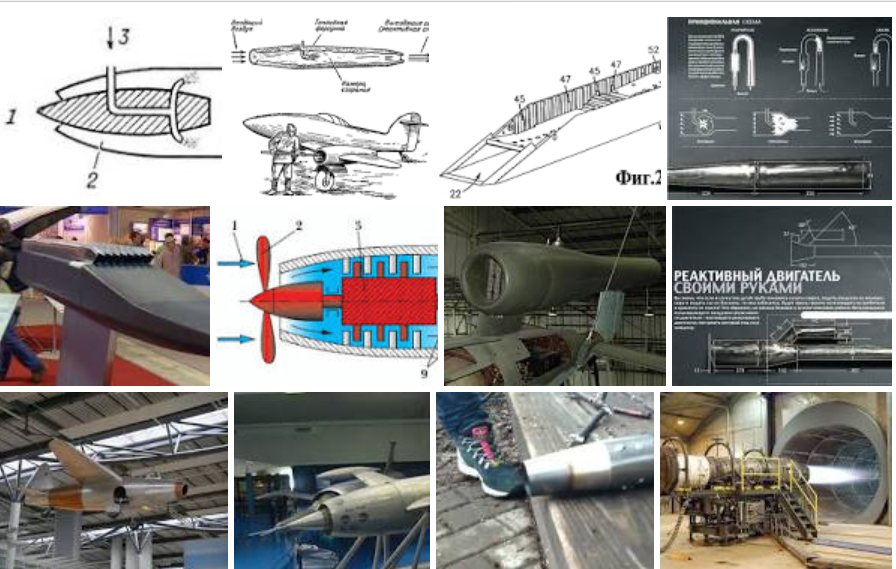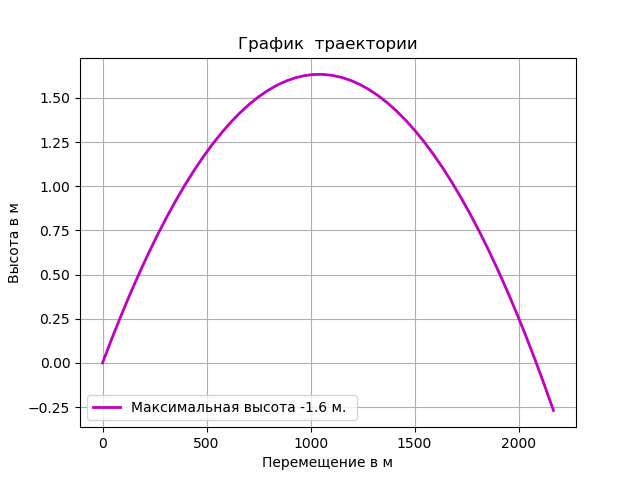Armor-piercing shells with a ramjet engine

Introduction
Currently, as armor-piercing ammunition, armor-piercing feathered sub-caliber projectiles (BOPS), possessing high penetrating power, are widely used.
This is achieved due to the high initial velocity of the ammunition (1650 - 1840 m / s) and small cross-section (d = 20-30 mm). To compensate for the force of air resistance apply jet thrust ammunition.
')
The ramjet engine, which is simple in design, has a high efficiency at large Mach numbers, is compact because it does not require an oxidizing agent in the composition of the fuel, since it uses the oxygen of the environment [1].
The principle of operation of ramjet engines
Air at flight speed enters the engine inlet device is braked to 0.1–0.2 Mach, while the kinetic energy of the air is converted into internal energy and its pressure and temperature increase. Air can be considered an ideal gas, so the ratio of its static pressure to atmospheric is determined by the ratio:
 (one)
(one)where p is the pressure in the fully inhibited flow; po is atmospheric pressure; Mn is the Mach number; k– The adiabatic index is 1.4.
Compressed air entering from the input device into the combustion chamber is heated due to oxidation of the fuel supplied to it. The gas mixture formed from the mixture of air with combustion products - the working fluid in the nozzle reaches the sonic velocity, and expands to supersonic at its output.
The working fluid flows out at a speed greater than the speed of the oncoming airflow, which creates jet thrust.
When the flight speed is significantly less than the speed of a jet stream, the thrust increases. As the speed of flight approaches the speed of a jet, the thrust drops, passing a certain maximum corresponding to the optimum speed of flight. Schemes of work of a direct-flow jet engine on liquid and solid fuel are shown respectively in Figures 1.2:


Ramjet thrust force is determined from the relationship:
 (2)
(2)where: P - traction force; v– flight speed; ve is the jet velocity relative to the engine; dmf / dt - second fuel consumption.
Secondary air flow is determined by the formula:
 (3)
(3)Where
 - air density (depends on height); dV / dt is the volume of air that enters the ramjet air intake unit of time; S is the cross-sectional area of the air inlet entrance; v - flight speed.
- air density (depends on height); dV / dt is the volume of air that enters the ramjet air intake unit of time; S is the cross-sectional area of the air inlet entrance; v - flight speed.To determine the second consumption of the working fluid for the ideal case, when the fuel is completely burned and the oxygen of the air is fully used in the combustion process, we use the formula:
 (four)
(four)where: L - stoichiometric coefficient of fuel and air.
With the development of composite solid fuel technology, it has become used in ramjet engines. The fuel checker with a longitudinal central channel is placed in the combustion chamber. The working fluid passing through the combustion chamber oxidizes the fuel from its surface and heats itself.
The use of solid fuel further simplifies the construction of a ramjet engine because it does not need a combustion chamber.
The main part of the ramjet fuel mix filler is the fine aluminum, magnesium or beryllium powder, the heat of combustion, which is much higher than the heat of combustion of hydrocarbon fuels.
An example of a solid-propellant ramjet engine is the mid-flight engine of the P-270 Mosquito anti-ship missile.
Depending on the flight speed, the ramjet is divided into subsonic, supersonic and hypersonic. This separation is due to the design features of each of these groups.
In a supersonic range, ramjet is significantly more efficient than subsonic. For example, at a speed of M = 3, the degree of pressure increase in a ramjet is 37, which is comparable to the highest pressure compressors of turbojet engines.
Design BOPS with ramjet
One of the main parameters that allows us to evaluate the design of the projectile is a low air resistance force. Consider one of the well-known armor-piercing feathered sub-caliber shells BM-9 with a solid-fuel engine.
The design of the BM-9 and the results of its aerodynamic studies in the Solidworks program, obtained in [2], are shown in the following figures 3,4,5. The final speed of the BM-9 is 1500 m / s at the time of arrival at a distance of 2120 m.

Figure 3. - Armor-piercing piercing projectile BM-9

Figure 4 - Distribution of airflow pressure created during the flight of the BM-9.

Figure 5 - Distribution of airspeed rates created during the flight of the BM-9
The calculation of the force of air resistance when moving BOPS
To build the law of air resistance force, it is required to process the experimental data obtained in [2] (see table) for the projectile shape (Fig. 3) and express the relationship between speed and air resistance force.

I give the listing of the program in Python, which demonstrates the possibility of solving the problem of obtaining the function Rc (V) in a convenient form for further use:
Graphs of the function of air resistance to speed
# -*- coding: utf8 -*- import numpy as np from scipy.integrate import odeint import scipy as sp from scipy.interpolate import interp1d import matplotlib.pyplot as plt x =np.array([1800, 1700, 1600,1500,1400 ,1300 ,1200, 1100]) y =np.array([ 1102, 979, 836, 705, 603, 534, 2717,2029]) new_length = 800 new_x = np.linspace(x.min(), x.max(), new_length) new_y = sp.interpolate.interp1d(x, y, kind='cubic')(new_x) plt.figure() plt.title(' Rc(V) ') plt.ylabel(' Rc(V) ') plt.xlabel(' V /') plt .plot(x,y,'r',linewidth=2,label=' ') plt .plot(x,y,'o',label=' ') plt.legend(loc='best') plt.grid(True) plt.figure() plt.title(' Rc(V) ') plt.ylabel(' Rc(V) ') plt.xlabel(' V /') plt .plot(new_x,new_y,'r',linewidth=2,label=' ') plt .plot(x,y,'o',label=' ') plt.legend(loc='best') plt.grid(True) plt.figure() plt.title(' Rc(V)') plt.ylabel(' Rc(V) ') plt.xlabel(' V /') plt .plot(new_x,new_y,'r',linewidth=2,label=' ') plt .plot(x,y,'o',label=' ') w_x=1800 w_y = sp.interpolate.interp1d(x, y, kind='cubic')(w_x) plt .plot(w_x,w_y ,'o',label=' Rc(%s) -%s'%(w_x,w_y)) plt.legend(loc='best') plt.grid(True) plt.figure() x =np.array([1800, 1700, 1600,1500,1400 ,1300]) y =np.array([ 1102, 979, 836, 705, 603, 534]) new_length = 400 new_x = np.linspace(x.min(), x.max(), new_length) new_y = sp.interpolate.interp1d(x, y, kind='cubic')(new_x) plt.title(' Rc(V)') plt.ylabel(' Rc(V) ') plt.xlabel(' V /') plt .plot(new_x,new_y,'r',linewidth=2,label=' ') plt .plot(x,y,'o',label=' 1800 ..1300 /') plt.legend(loc='best') plt.grid(True) plt.show() We get:



This graph shows us that if, when departing from the barrel, the velocity of the projectile in the ideal case reaches 1800 m / s, then this speed corresponds to the value of the air resistance force 1102 N.
When the speed on the trajectory decreases, the resistance force decreases according to the law, which is shown in the graph. Further, at a speed of about 1200 m / s, the resistance force begins to grow. This phenomenon is associated with the geometry of the confuser at the inlet of the ramjet air intake.
On jet planes, an adjustable air intake cone is used to combat this phenomenon. For the considered projectile, this is impossible because of the higher flight speeds within (1300 ... 1800) m / s. Therefore, the range of experimental data must be limited to obtain a working schedule:

The function Rc (v) for any experimental set can be obtained from the following short listing:
# -*- coding: utf8 -*- import numpy as np import scipy as sp from scipy.interpolate import interp1d x =np.array([1800, 1700, 1600,1500,1400 ,1300 ,1200, 1100]) y =np.array([ 1102, 979, 836, 705, 603, 534, 2717,2029]) def Rc(new_x): new_y = sp.interpolate.interp1d(x, y, kind='cubic')(new_x) return new_y Calculation of external ballistics BOPS
Since the shot with the aiming is made from a certain trunk, we will be interested in the range taking into account the thrust force.
Determination of thrust force
Using all the formulas (2) ÷ (4) you can determine the force of thrust. To begin, we determine the second air flow:

Where
 = 1.205 kg / m3 (Air density from the Clapeyron equation at T = 0); V = 1800 m / s - the velocity of the projectile (according to the condition).
= 1.205 kg / m3 (Air density from the Clapeyron equation at T = 0); V = 1800 m / s - the velocity of the projectile (according to the condition).Second fuel consumption, which will correspond to the second air consumption:

where L = 14.7; which corresponds to jet fuel "RT" (table)
Table - The stoichiometric composition of the combustible mixture, expressed as the ratio of the oxidizer to the fuel.

According to the data of [2], the speed of the jet for the above parameters is V = 1840 m / s. Determine the force of thrust from the relation (2):

The system of equations of external ballistics
Consider the scheme of forces acting on the center of mass of an unguided projectile in flight:

The system of equations will go through the form:
 (five)
(five)The numerical values of the parameters:
 (6)
(6)Initial conditions:
 (7)
(7)The system of differential equations (5), taking into account (6) and (7), will be solved using Python tools, redefining the variables as y1, y2, y3, y4:
Numerical solution of a system of differential equations
# -*- coding: utf8 -*- import numpy as np from scipy.integrate import odeint import scipy as sp from scipy.interpolate import interp1d import matplotlib.pyplot as plt # 1900 /c x =np.array([1900,1800, 1700, 1600,1500,1400 ,1300]) y =np.array([ 1225,1102, 979, 836, 705, 603, 534]) def Rc(new_x): # new_y = sp.interpolate.interp1d(x, y, kind='cubic')(new_x) return new_y def f(y,t):# y1,y2,y3,y4=y return [-9.81*np.cos(y1)/y2, 1181/6.77 -Rc(y2)/6.77 -9.81*np.sin(y1),y2*np.cos(y1),y2*np.sin(y1)] t=np.linspace(0,1.2,50)# y0=[0.18*np.pi/180,1800,0,0]# - , , [y1,y2,y3,y4]=odeint(f,y0,t,full_output=False).T# plt.figure() plt.title(' ') plt.ylabel(' ') plt.xlabel(' ') plt .plot(t,y4,'r',linewidth=2,label=' -%s .'%max(t)) plt.legend(loc='best') plt.grid(True) plt.figure() plt.title(' ') plt.ylabel(' /c') plt.xlabel(' ') plt .plot(y3,y2,'b',linewidth=2,label=' -%s .'%round(max(y3),1)) plt.legend(loc='best') plt.grid(True) plt.figure() plt.title(' ') plt.ylabel(' /c') plt.xlabel(' ') plt .plot(t,y2,'g',linewidth=2,label=' -%s /'%round(max(y2),1)) plt.legend(loc='best') plt.grid(True) plt.figure() plt.title(' ') plt.ylabel(' ') plt.xlabel(' ') plt .plot(y3,y4,'m',linewidth=2,label=' -%s . '%round(max(y4),1)) plt.legend(loc='best') plt.grid(True) plt.show() We get:




The ballistic characteristics are shown in the graphs, the negative areas are preserved for clarity of the transition through zero.
findings
The features of armor-piercing projectiles with a ramjet engine are considered, the main calculations are made using the tools of the high-level programming language Python.
References:
1. Artyomov O.A. Direct-flow jet engines (calculation of characteristics): Monograph. - M: Sputnik + Company, 2006. - 374 p.
2. Gavrilov K.S. Designing an armor-piercing piercing projectile with a ramjet engine.
Source: https://habr.com/ru/post/348974/
All Articles